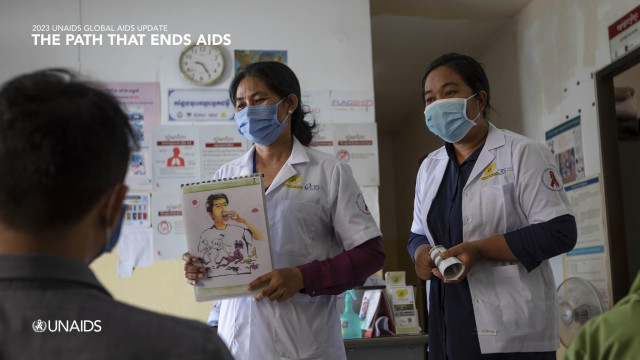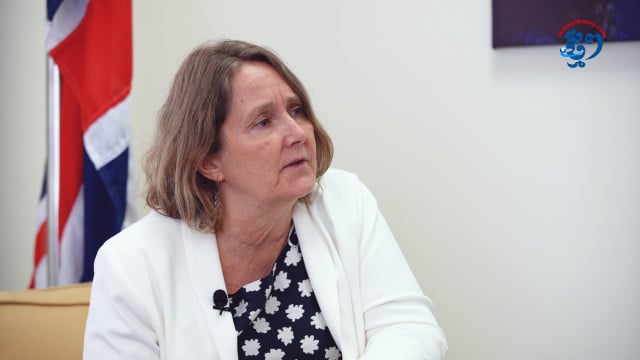Teach Young About HIV to Curb Infections: Experts

- By Meng Seavmey
- August 13, 2023 7:00 PM
BANGKOK – Spreading awareness of HIV protection and prevention is necessary to fill the knowledge gap among young people and cut infections, experts say. However, action is needed to make it happen.
Tia Phalla, vice chair of the National AIDS Authority (NAA), said people aged 15 to 24 shared around 42% of cases, which is a concerning number. Only 27% of the young people knew about the prevention method.
Working on AIDS is divided into three stages: stopping the virus from infecting, providing services to people living with AIDS, and treating all people getting services regularly to suppress viral loads.
The UNAIDS 95–95–95 targets mean that 95% of people within the subpopulation who are living with HIV know their HIV status, 95% of people who know their HIV status are on antiretroviral therapy, and 95% of people on antiretroviral therapy have suppressed viral loads.
According to the vice chair, Cambodia has successfully achieved the second and the third targets with 99% and 98% respectively, which is a great tribute to the country’s process in protecting and preventing HIV.
However, Cambodia has not reached the first goal yet, as the young people, including men who have sex with men, do not know enough about protection and prevention of HIV.
“I don’t think the country will achieve the target by 2025, because young people are not aware that AIDS still exists, which makes prevention more difficult,” he said the vice chairman.
The HIV Estimates 2022 study conducted by NAA, National Center for HIV/AIDS, Dermatology and STD (NCHADS), and UNAIDS said that only 38% of young women and 46% of young men had knowledge about AIDS.
The actions are needed, not only knowledge
The increasing number of young people with HIV also happens in the Asia and the Pacific countries. Data specialist Ye Yu Shwe said in June that as a quarter of the total HIV infections in the region are among this group, and most of them are among the key populations and their sexual partners.
“Young people are the next generation, so the group getting infected with HIV is a concern,” he said.
“When going to the next phase of their life, the young people have a lot of things introduced to them, including sex, drugs, and alcohol. At the same time, the information about HIV or those sexually transmitted diseases is actually not enough to reach out to them.”
Nevertheless, he believes that spreading information is not enough to prevent HIV infection. Young people’s actions are needed to protect themselves.
As it is now a digital era, the means to reach out to young people should be modernized as well. He said, “To reach out to these people, you need to approach them, you need to walk with them, you need to let them lead. They know what is happening so that they can use their knowledge to actually help their peers.”
According to data, 1,400 people have been diagnosed with HIV in Cambodia recently, which is an increase of 300 cases compared to 2021. About 83% were in the high-risk population and their sex partners. Of the latter figure, 40% were among men who have sex with men.
Fear of discrimination is a barrier
Patricia Ongpin, country director for the UNAIDS Multi-Country Office for Cambodia, Lao PDR and Malaysia, said almost all people living with HIV in Cambodia who know their HIV status receive HIV treatment, however only 86% of estimated people living with HIV know their HIV status and the number of annual new HIV infections has not decreased in the past five years.
Despite the significant progress in the country’s HIV response, more efforts are needed to help people who are not aware of their HIV status yet and make sure that people who are vulnerable to HIV transmission get the prevention options they need.
Based on the latest evidence, there is a lack of awareness and knowledge among young people about the protection and prevention of HIV infection.
“When young people are aware of HIV prevention measures, they will be better able to reduce the risk of getting infected with HIV. This would result in less young people being newly infected with HIV,” the director said.
Such HIV prevention measures to use in combination include use of condoms, pre-exposure prophylaxis (PrEP - a once daily medication to prevent HIV infection) and using clean syringes for those who inject drugs.
To ensure that all people living with HIV know about their HIV status for timely treatment, stigma and discrimination that prevent them from accessing services also have to be addressed.
“Based on a study conducted in 2019, the stigma and discrimination experienced from families and society decreased, but the self-stigma of people living with HIV remains strong. The fear of discrimination from society is one of the factors for the self-stigma,” Ongpin said.
Likewise, the National AIDS Authority’s vice chair said some young people hide their status because they fear discrimination, which also prevents experts or doctors from reaching out to them.
“Both external and internal discrimination can be the reasons they are still hiding themselves,” he said.
Making young people aware of their status and ensuring that they are given services and treatment regularly are the means to reduce cases.
As a request to the doctors cooperating with the National Social Security Fund (NSSF), the vice chairman called on them to continue providing the service to people with HIV as attentively as they treat people who do not have HIV.
“We need to make them feel warm and close to us for them to open up. We should feel empathy for them,” he said.
Under the global partnership for action to eliminate all forms of HIV-related stigma and discrimination, Cambodia will have an action plan to address stigma and discrimination, which is not only among people living with HIV but also the key populations and young people.















